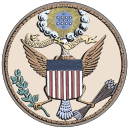Idaho Territory in the American Civil War
 |
|
Union states in the American Civil War |
|---|
|
|
| Dual governments |
| Territories and D.C. |
The history of Idaho in the American Civil War is atypical, as the territory was far from the battlefields.
At the start of the Civil War, modern-day Idaho was part of the Washington Territory. On March 3 1863, the Idaho Territory was formed, consisting of the entirety of modern day Idaho, Montana, and all but southwest Wyoming. However, there were concerns about Confederate sympathizers in the eastern half of the territory, in what is present-day Montana. As a result, in 1863 Sidney Edgerton traveled quickly to see President Abraham Lincoln about the situation; this was one reason to split the Montana Territory from the Idaho Territory. The split also resulted in most of Idaho Territory's land consisting of modern-day Wyoming being reassigned to the Dakota Territory.[1]
Soldiers who served in Idaho did not fight against the Confederacy, but instead monitored traffic along the Oregon Trail and protected communications routes between the western and eastern United States. Fort Boise, at the site of the future capital of Idaho, was built during this period because of attacks against travelers on the trail.
The Bear River massacre took place on January 29 1863, on what was thought to be the boundary of Washington Territory and Utah Territory near the present-day city of Preston in Franklin County, Idaho. On that date, 300 soldiers of the 3rd California Volunteer Infantry Regiment led by Colonel Patrick Connor slaughtered an encampment of at least 250 members of the Shoshone tribe; only about twenty Shoshoni men survived. This was in response to numerous attacks against white settlers in the previous year which were blamed on the Shoshone. The incident saw little coverage outside California and Utah, as most major newspapers were concerned with news of the main war fronts. The Bear River Massacre Site is currently a National Historic Landmark.[2][3][4]
There were some southerners in the territory at the time. Most had originally gone to California, and came to Idaho to pursue gold mining.[5]
After the war, Idaho attracted many veterans of the Union Army to the state, including several governors. An Idaho Soldiers Home was constructed during the 1890s. In the 20th century, the deaths of veterans routinely made the news. The last Civil War veteran to die in Idaho was Israel Broadsword in 1952.[6]
See also
References
- ^ Sargent, Tom. The Commanding Officers in Montana, The Civil War in Montana. Virginia City Preservation Alliance, 1999.
- ^ Bearss, Edwin. Bear River Battleground (National Park Service, 1990) pg. 8.2
- ^ Bear River Massacre at Boa Ogoi, Idaho (American Civil War.com)
- ^ Heidler, David. Encyclopedia of the American Civil War (W. W. Norton & Company, 2002) pg. 485
- ^ Dunn, Jacob. Indiana and Indianans (The American historical society, 1919) pg. 1166
- ^ House, Rod. Civil War Veterans in Idaho (Idaho State Historical Society 2007)
